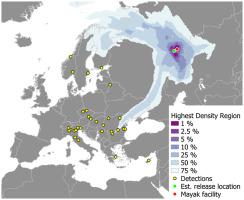Journal of Environmental Radioactivity ( IF 1.9 ) Pub Date : 2021-05-24 , DOI: 10.1016/j.jenvrad.2021.106643 Jasper M. Tomas , Valesca Peereboom , Astrid Kloosterman , Arjan van Dijk

|
The detection of radioactivity of unknown origin necessitates the use of models that can quantify unknown corresponding source term parameters. In this work, a method for solving this inverse problem is described. The main goal of the method is that it can be used in emergency response. Therefore, the full modelling chain dealing with the collection and pre-processing of measurement data, source term estimation, (forward) dispersion modelling, and consequence assessment are discussed. Firstly, to verify this inverse model SHERLOC, the part of the modelling chain concerning the source term estimation based on measurement data, is applied to the first episode of the European Tracer Experiment (ETEX). Secondly, the complete model chain is applied to a release that is still unaccounted for; the 106Ru measured in the atmosphere of Europe in September and October of 2017. It is estimated that during the night of the 25th to the 26th of September 2017 approximately 1.33 PBq ( Bq) of 106Ru was emitted at a location in the region of the Southern Urals in the Russian Federation. Statistical indicators show that the modelled levels of concentration are in good agreement with the measurements. The radiological consequences of the release are estimated to be minor at distances farther than 22 km from the estimated source. However, in the vicinity of the emission the maximum committed dose received by the public may have exceeded 100 mSv. Since the presented approach can be executed within few hours after the collection of measurement data it can be used in the emergency response following the detection of radioactivity of unknown origin.
中文翻译:

未知来源放射性的检测:基于逆模型的防护作用
要检测未知来源的放射性,就必须使用可以量化未知的相应源项参数的模型。在这项工作中,描述了解决该反问题的方法。该方法的主要目标是可以用于应急响应。因此,讨论了涉及测量数据的收集和预处理,源项估计,(正向)色散建模以及结果评估的完整建模链。首先,为验证此逆模型SHERLOC,将建模链中与基于测量数据的源项估计有关的部分应用于“欧洲示踪剂实验”(ETEX)的第一集。其次,将完整的模型链应用于尚未说明的发行版;在106Ru在2017年9月和10月的欧洲大气中测得。据估计,在2017年9月25日至26日夜间,约1.33 PBq(在俄罗斯联邦南部乌拉尔地区的某个位置发射了106 Ru的Bq)。统计指标表明,建模的浓度水平与测量值非常吻合。据估计,与放射源的距离超过22公里,释放的放射学后果很小。但是,在发射附近,公众收到的最大承诺剂量可能已经超过100 mSv。由于所提出的方法可以在收集测量数据后的几个小时内执行,因此可以在检测到未知来源的放射性之后用于应急响应。











































 京公网安备 11010802027423号
京公网安备 11010802027423号